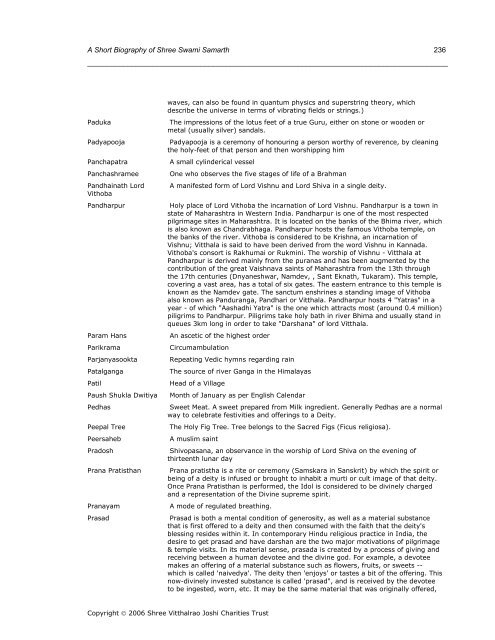Shree Swami Samarth Maharaj
Shree Swami Samarth Maharaj
Shree Swami Samarth Maharaj
Create successful ePaper yourself
Turn your PDF publications into a flip-book with our unique Google optimized e-Paper software.
A Short Biography of <strong>Shree</strong> <strong>Swami</strong> <strong>Samarth</strong> 236<br />
_________________________________________________________________________________________<br />
waves, can also be found in quantum physics and superstring theory, which<br />
describe the universe in terms of vibrating fields or strings.)<br />
Paduka The impressions of the lotus feet of a true Guru, either on stone or wooden or<br />
metal (usually silver) sandals.<br />
Padyapooja Padyapooja is a ceremony of honouring a person worthy of reverence, by cleaning<br />
the holy-feet of that person and then worshipping him<br />
Panchapatra A small cylinderical vessel<br />
Panchashramee One who observes the five stages of life of a Brahman<br />
Pandhainath Lord<br />
Vithoba<br />
A manifested form of Lord Vishnu and Lord Shiva in a single deity.<br />
Pandharpur Holy place of Lord Vithoba the incarnation of Lord Vishnu. Pandharpur is a town in<br />
state of Maharashtra in Western India. Pandharpur is one of the most respected<br />
pilgrimage sites in Maharashtra. It is located on the banks of the Bhima river, which<br />
is also known as Chandrabhaga. Pandharpur hosts the famous Vithoba temple, on<br />
the banks of the river. Vithoba is considered to be Krishna, an incarnation of<br />
Vishnu; Vitthala is said to have been derived from the word Vishnu in Kannada.<br />
Vithoba's consort is Rakhumai or Rukmini. The worship of Vishnu - Vitthala at<br />
Pandharpur is derived mainly from the puranas and has been augmented by the<br />
contribution of the great Vaishnava saints of Maharashtra from the 13th through<br />
the 17th centuries (Dnyaneshwar, Namdev, , Sant Eknath, Tukaram). This temple,<br />
covering a vast area, has a total of six gates. The eastern entrance to this temple is<br />
known as the Namdev gate. The sanctum enshrines a standing image of Vithoba<br />
also known as Panduranga, Pandhari or Vitthala. Pandharpur hosts 4 "Yatras" in a<br />
year - of which "Aashadhi Yatra" is the one which attracts most (around 0.4 million)<br />
piligrims to Pandharpur. Piligrims take holy bath in river Bhima and usually stand in<br />
queues 3km long in order to take "Darshana" of lord Vitthala.<br />
Param Hans An ascetic of the highest order<br />
Parikrama Circumambulation<br />
Parjanyasookta Repeating Vedic hymns regarding rain<br />
Patalganga The source of river Ganga in the Himalayas<br />
Patil Head of a Village<br />
Paush Shukla Dwitiya Month of January as per English Calendar<br />
Pedhas Sweet Meat. A sweet prepared from Milk ingredient. Generally Pedhas are a normal<br />
way to celebrate festivities and offerings to a Deity.<br />
Peepal Tree The Holy Fig Tree. Tree belongs to the Sacred Figs (Ficus religiosa).<br />
Peersaheb A muslim saint<br />
Pradosh Shivopasana, an observance in the worship of Lord Shiva on the evening of<br />
thirteenth lunar day<br />
Prana Pratisthan Prana pratistha is a rite or ceremony (Samskara in Sanskrit) by which the spirit or<br />
being of a deity is infused or brought to inhabit a murti or cult image of that deity.<br />
Once Prana Pratisthan is performed, the Idol is considered to be divinely charged<br />
and a representation of the Divine supreme spirit.<br />
Pranayam A mode of regulated breathing.<br />
Prasad Prasad is both a mental condition of generosity, as well as a material substance<br />
that is first offered to a deity and then consumed with the faith that the deity's<br />
blessing resides within it. In contemporary Hindu religious practice in India, the<br />
desire to get prasad and have darshan are the two major motivations of pilgrimage<br />
& temple visits. In its material sense, prasada is created by a process of giving and<br />
receiving between a human devotee and the divine god. For example, a devotee<br />
makes an offering of a material substance such as flowers, fruits, or sweets --<br />
which is called 'naivedya'. The deity then 'enjoys' or tastes a bit of the offering. This<br />
now-divinely invested substance is called 'prasad", and is received by the devotee<br />
to be ingested, worn, etc. It may be the same material that was originally offered,<br />
Copyright © 2006 <strong>Shree</strong> Vitthalrao Joshi Charities Trust


